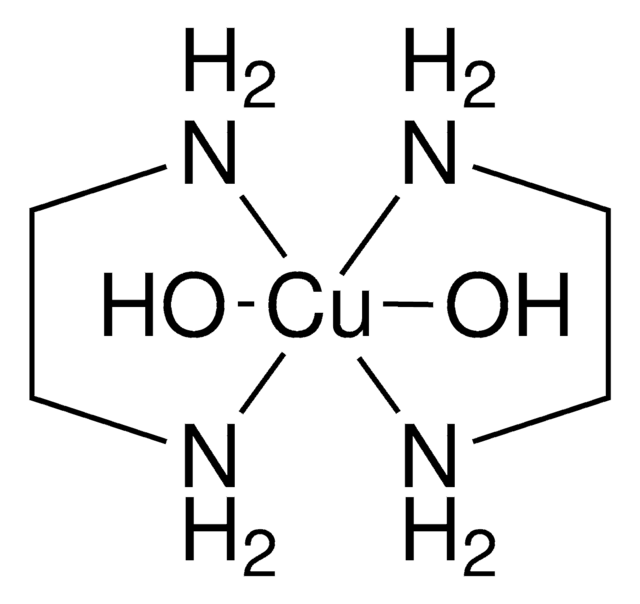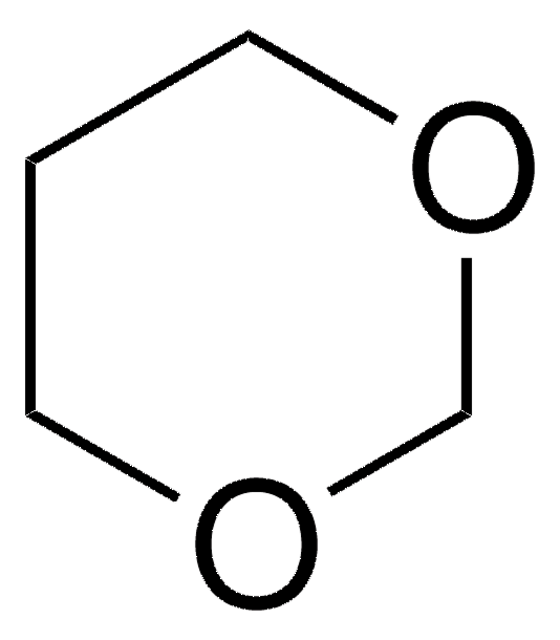296309
1,4 Dioxano
anhydrous, 99.8%, contains <=25 ppm BHT as stabilizer
Sinónimos:
Dioxano, Óxido de dietileno
About This Item
40 mmHg ( 25 °C)
Productos recomendados
grado
anhydrous
Nivel de calidad
densidad de vapor
3 (vs air)
presión de vapor
27 mmHg ( 20 °C)
40 mmHg ( 25 °C)
Ensayo
99.8%
Formulario
liquid
temp. de autoignición
356 °F
lim. expl.
22 %
impurezas
<0.003% water
<0.005% water (100 mL pkg)
residuo de evap.
≤0.005%
índice de refracción
n20/D 1.422 (lit.)
pH
6.0-8 (20 °C, 500 g/L)
bp
100-102 °C (lit.)
mp
10-12 °C (lit.)
densidad
1.034 g/mL at 25 °C (lit.)
cadena SMILES
C1COCCO1
InChI
1S/C4H8O2/c1-2-6-4-3-5-1/h1-4H2
Clave InChI
RYHBNJHYFVUHQT-UHFFFAOYSA-N
¿Está buscando productos similares? Visita Guía de comparación de productos
Aplicación
It may be used as a solvent to synthesize:
- (Chloromethyl)dimethylphenylsilane from chloro(chloromethyl)dimethylsilane via zinc-catalyzed substitution reaction with phenylmagnesium bromide.
- N-(2,2,2-trifluoro-1-hydroxyethyl)-acetamide from 2,2,2-trifluoro-1-methoxyethanol and acetamide.
Envase
Otras notas
Opcional
Producto relacionado
también adquirido normalmente con este producto
Palabra de señalización
Danger
Frases de peligro
Consejos de prudencia
Clasificaciones de peligro
Carc. 1B - Eye Irrit. 2 - Flam. Liq. 2 - STOT SE 3
Órganos de actuación
Respiratory system
Riesgos supl.
Código de clase de almacenamiento
3 - Flammable liquids
Clase de riesgo para el agua (WGK)
WGK 3
Punto de inflamabilidad (°F)
51.8 °F - closed cup
Punto de inflamabilidad (°C)
11 °C - closed cup
Equipo de protección personal
Eyeshields, Faceshields, Gloves, type ABEK (EN14387) respirator filter
Elija entre una de las versiones más recientes:
¿Ya tiene este producto?
Encuentre la documentación para los productos que ha comprado recientemente en la Biblioteca de documentos.
Los clientes también vieron
Artículos
All of the preformed catalysts used in the kit are air and moisture stable complexes in their commercially available form. Once activated by base under the reaction conditions they become sensitive to air. To best enable scale-up success, the use of standard Schlenk technique is recommended.
All of the preformed catalysts used in the kit are air and moisture stable complexes in their commercially available form. Once activated by base under the reaction conditions they become sensitive to air. To best enable scale-up success, the use of standard Schlenk technique is recommended.
Substances are said to be miscible in one another if they dissolve to form a uniform solution. Bookmark or download our miscibility table for common lab solvents.
Nuestro equipo de científicos tiene experiencia en todas las áreas de investigación: Ciencias de la vida, Ciencia de los materiales, Síntesis química, Cromatografía, Analítica y muchas otras.
Póngase en contacto con el Servicio técnico







